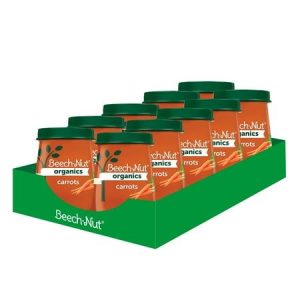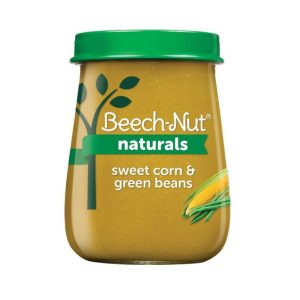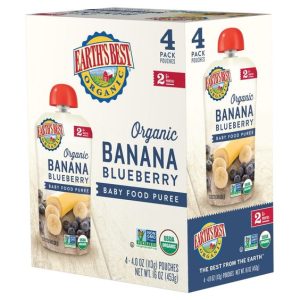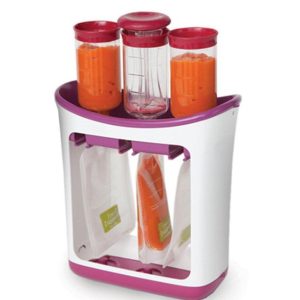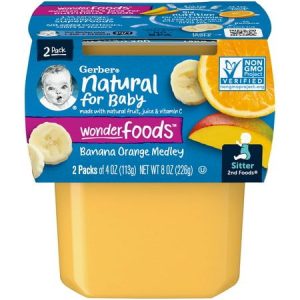Introducing your baby to solid foods is an exciting milestone! But with so many options, what are the best first purees for your little one? What are the best purees to start with for babies? This article explores the world of baby purées, offering guidance on choosing healthy and delicious first bites.
The Wonderful World of Purees
Around 6 months of age, most babies are developmentally ready for solid foods. Find the best purees to start with for babies. Purees are a great way to introduce new flavors and textures while giving your baby practice with swallowing. Here’s why purees are perfect for beginners:
Smooth and Easy to Swallow:
Purees are smooth and easy for babies to swallow, reducing the risk of choking.
Nutrient Rich:
Purees made from fruits, vegetables, and other wholesome foods provide essential nutrients for your baby’s growth.
Exposure to New Flavors:
Purees introduce your baby to a variety of flavors, helping them develop a taste for healthy foods.
Choosing the Right First Purees
When selecting first purees, simplicity is key. Here are some factors to consider:
- Single Ingredient: Start with single-ingredient purees made from one fruit or vegetable at a time. This helps identify any potential food allergies.
- Bland is Best: Strong flavors can be overwhelming for babies. Opt for naturally mild-flavored fruits and vegetables like avocado, sweet potato, or banana.
- Ripe and Fresh: Use ripe fruits and vegetables for the sweetest flavor and smoothest texture.
Delicious and Nutritious Puree Options
Now, let’s explore some fantastic options for first purees!
-
Fruits: Avocados, bananas, apples, pears, and mangoes are all great choices. They’re naturally sweet and blend easily into a smooth consistency.
-
Vegetables: Sweet potatoes, peas, carrots, and green beans are all nutritious and have a mild flavor well-suited for beginners.
-
Single-Grain Cereals: Rice cereal, oatmeal, or barley cereal mixed with breastmilk or formula can be a good first food option.
Remember: Always consult your pediatrician before introducing solid foods to your baby. They can advise you on the best time to start and any potential allergens to consider.
Beyond the Basics: Variety and Texture
Once your baby has enjoyed a few single-ingredient purees, you can gradually introduce more variety. Here’s how to expand your baby’s palate:
-
Mix and Match: Once your baby is comfortable with single flavors, try combining two fruits or vegetables together. For example, sweet potato and apple or pear and avocado.
-
Texture Variations: As your baby gets the hang of swallowing purees, you can introduce slightly thicker textures. Mash cooked fruits and vegetables instead of pureeing them completely.
-
New Grains: Introduce other grain varieties like quinoa or millet, cooked and mashed to a smooth consistency.
Remember: Always monitor your baby for any signs of allergic reaction when introducing new foods.
Making Your Own Purees vs. Store-Bought
You can create delicious and nutritious purees for your baby at home or choose from a wide variety of store-bought options. Do you know whta are the best purees to start with for babies? Here’s a quick comparison:
-
Homemade Purees: Offer complete control over ingredients and freshness. They can be more cost-effective in the long run.
-
Store-Bought Purees: Convenient and often fortified with additional vitamins and minerals. Be sure to choose varieties with no added sugar or preservatives.
Puree Preparation and Storage Tips
Making your own baby food is a rewarding experience. Here are some tips for preparing and storing homemade purees:
-
Steaming or Boiling: Steam or boil fruits and vegetables to preserve nutrients and soften them for easy blending.
-
Blending: Use a blender or food processor to create a smooth puree.
-
Storage: Store leftover purees in airtight containers in the refrigerator for up to 3 days or freeze them in ice cube trays for longer storage.
The Importance of Enjoying Mealtimes
Mealtimes should be a positive and enjoyable experience for both you and your baby. Here are some tips:
-
Relaxed Atmosphere: Create a relaxed and stress-free mealtime environment.
-
Follow Your Baby’s Lead: Let your baby take the lead. Don’t force them to eat more than they want.
-
Make it Fun: Use colorful bowls and spoons, sing songs, and narrate what your baby is eating.
Introducing your baby to solid foods is a journey of discovery. By following these tips and guidance from your pediatrician, you can create a positive and enjoyable experience for your little one. Remember, the most important thing is to provide a variety of healthy and delicious purees for your baby.
Graduating Beyond Single-Ingredient Purees
Once your baby has enjoyed a few single-ingredient purees and shown no signs of allergies, you can gradually introduce more variety and texture. Here are some tips for expanding your baby’s palate:
-
Mix and Match Flavors: Now that your baby is comfortable with single flavors, try combining two fruits or vegetables together. This exposes them to new flavor combinations and helps them develop a taste for more complex flavors. Start with fruits and vegetables that naturally complement each other, like sweet potato and apple or pear and avocado.
-
Gradual Texture Progression: As your baby gets the hang of swallowing purees, you can introduce slightly thicker textures. This helps them develop their chewing skills in preparation for more solid foods later on. Mash cooked fruits and vegetables instead of pureeing them completely. You can also start introducing spoon-feeding with thicker purees to encourage self-feeding.
-
Introduce New Grains: Branch out from rice cereal and explore other grain varieties like quinoa or millet. Cook them until soft and mash them to a smooth consistency.
Remember: Always monitor your baby for any signs of allergic reaction when introducing new foods. If you notice any redness, fussiness, or vomiting, stop offering that particular food and consult your pediatrician.
Making Mealtimes Fun and Engaging
Mealtimes should be a positive and enjoyable experience for both you and your baby. Here are some tips to create a happy and stress-free environment:
-
Relaxed Atmosphere: Set the mood for a positive mealtime by creating a relaxed and unhurried atmosphere. Avoid distractions like television or loud noises.
-
Follow Your Baby’s Lead: Let your baby take the lead during mealtimes. Offer them bites of food and allow them to explore the flavors and textures at their own pace. Don’t force them to eat more than they want.
-
Make it Playful: Use colorful bowls and spoons to capture your baby’s attention. Sing songs or narrate what your baby is eating to keep them engaged. Mealtime can be a great opportunity for bonding and learning.
Conclusion
Introducing best purees to start with for babies is a journey of discovery and exploration. By following these tips and guidance from your pediatrician, you can create a positive and enjoyable experience for your little one as they explore new flavors and textures. Remember, the most important thing is to provide a variety of healthy and delicious purees to nourish your baby and support their growth and development.

